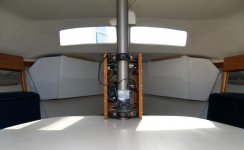I wonder how these sound...and what they cost: http://www.tannoypro.com/#!Page=Product&Id=71.294
Originally Posted by weltersys
Make a curved cone to extend the HF horn, which has problems because the horn "wiggles" in use. With modern driver cones having 6-8 mm or so Xmax, there is a definite discontinuity that changes forward and backwards with each wave so the problem is worse than with older, limited Xmax designs.
If you are going three way, using offset mid and low mid drivers sharing the horn with a compression driver at the apex of the horn (as in DSL's Synergy designs) offers less of a compromise than raising the crossover point to limit excursion. The acoustical HP the offset horn provides also reduces excursion related distortion, and all drivers sharing a relatively large horn takes pattern control to a much lower frequency.
Art
Make a curved cone to extend the HF horn, which has problems because the horn "wiggles" in use. With modern driver cones having 6-8 mm or so Xmax, there is a definite discontinuity that changes forward and backwards with each wave so the problem is worse than with older, limited Xmax designs.
Wowo,We can address that problem, too – just add a dedicated woofer and HP the midrange driver of the coaxial at a frequency where cone travel isn't a problem (the horn doesn't "wiggle") anymore.
If you are going three way, using offset mid and low mid drivers sharing the horn with a compression driver at the apex of the horn (as in DSL's Synergy designs) offers less of a compromise than raising the crossover point to limit excursion. The acoustical HP the offset horn provides also reduces excursion related distortion, and all drivers sharing a relatively large horn takes pattern control to a much lower frequency.
Art
If you are going three way, using offset mid and low mid drivers sharing the horn with a compression driver at the apex of the horn (as in DSL's Synergy designs) offers less of a compromise than raising the crossover point to limit excursion. The acoustical HP the offset horn provides also reduces excursion related distortion, and all drivers sharing a relatively large horn takes pattern control to a much lower frequency.
Yes, I have been looking into Synergy designs, too, but they quickly exceed what's possible in my living/listening room situation, sizewise. This is why I'm looking into larger coaxes as kind of a compromise between Synergy size and smaller coax speakers.
Yep, that is why I have near flat boxes in corners in my living room, Synergies would block one of the windows. If only I would have thought ahead 17 years ago when I put the window in...Yes, I have been looking into Synergy designs, too, but they quickly exceed what's possible in my living/listening room situation, sizewise. This is why I'm looking into larger coaxes as kind of a compromise between Synergy size and smaller coax speakers.
Don't know what your SPL requirements are, but I a pair of cabinets using Seas P 17 Coax with a Vifa bass assist cone in 1996. At the time had never heard of Seas or Vifa, being pretty much only into pro sound. Took it all on faith from Bob Oswood that they would work out, and they did, surpassing my expectations.
The P 17 coax went in a .4 cubic foot box tuned to 45 Hz, a port 6 square inches, 12 inch deep.
The Vifa woofer (bass assist cone), the model number which has escaped me, went in a 1 cubic foot box tuned to 37.5 HZ, a port 8 square inches, 11.2 inches deep.
These ports are rather large, the area they take up is added to the box dimensions, as is the cone/driver displacement. Fiberglass insulation was put on two sides of the interior.
The cabinets were put in the “V” berth of the boat, and to achieve the correct toe-in, the speaker baffle was angled in around 45 degrees. Since the speakers are only 6.5” (as I recall) that angle allows the cabinet to be only about 5” deep from the side wall, but because it is so thin, around 3 foot deep, tapering thinner at the back of the cabinet, which is in the forward (pointy end) of the “V” berth. I put the ports on the outside, running flush against the hull.
This is the passive crossover design used:
+ -----RP1-----C1--------C2----------- +
------------------------L1---------RP2--- CoaxTweeter
- ------------------------------------- -
C1 = 3 uf
C2 = 7 uf
L1 = .43 mH
RP1 = 2 Ohm
Rp2 = 13 Ohm
______________________________
+ ------L1--------------------------- +
-----------------C1-------CJ----------Coax
--------------------------- RJ---------Woofer
- ------------------------------------ -
L1 = .36 mH
C1 = 16 uf
CJ = 39 uf
RJ = 8 Ohm
__________________________________
+-------L1--------------------------------- +
------------------------C1-------------------bass assist cone
- ------------------------------------------ -
L1 = 13.5 mH
C1 = 120 uf
or
L1 = 9.5 mH
C1 = 170 uf
From my notes I think used the latter combination.
In the boat cabin they could do around 110 dB down to the mid 30 Hz range using a stereo 10 watt amp.
I miss that stereo more than the boat....
Art
Attachments
Last edited:
That looks like a really smart setup!
I'll have to do some sims to get a feeling where a SEAS/woofer combo would take me SPL-wise. The other aspect that drew me to Synergy/large coax design was pattern control, though: From the graphs for the Tannoy install speakers Face linked to, I'd guess a 10" coax will reach a DI of 5 at about 600-700 Hz, compared to probably above 2 kHz with a small coax like the SEAS…
I'll have to do some sims to get a feeling where a SEAS/woofer combo would take me SPL-wise. The other aspect that drew me to Synergy/large coax design was pattern control, though: From the graphs for the Tannoy install speakers Face linked to, I'd guess a 10" coax will reach a DI of 5 at about 600-700 Hz, compared to probably above 2 kHz with a small coax like the SEAS…
I looked a little more into Tannoy drivers available for DIY, and of the ones Speaker Exchange carries, the Tannoy Dimension TD10 and TD12 drivers seem most interesting.
I found some independent measurements of the speakers using it here and here.
Both are using a Supertweeter which leads to severe interference effects above 10 kHz because of the high crossover point (which the Sound&Vision review seems to miss), but apart from that (and from some strange level mismatch in the TD10), the drivers themselves seem to be pretty well-behaved:
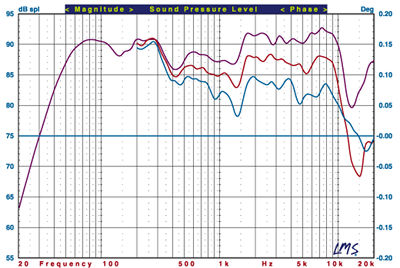
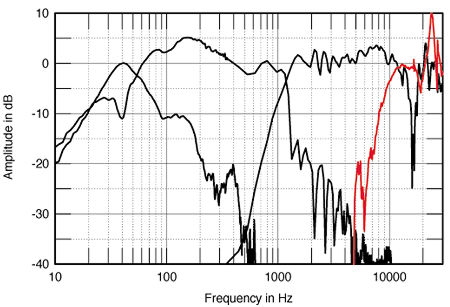
I don't know, though, if the CD in the coaxes has enough high end extension itself to be used without a supertweeter – has anyone any information on that?
I found some independent measurements of the speakers using it here and here.
Both are using a Supertweeter which leads to severe interference effects above 10 kHz because of the high crossover point (which the Sound&Vision review seems to miss), but apart from that (and from some strange level mismatch in the TD10), the drivers themselves seem to be pretty well-behaved:


I don't know, though, if the CD in the coaxes has enough high end extension itself to be used without a supertweeter – has anyone any information on that?
Yes, I have been looking into Synergy designs, too, but they quickly exceed what's possible in my living/listening room situation, sizewise. This is why I'm looking into larger coaxes as kind of a compromise between Synergy size and smaller coax speakers.
You might be able to fit some Trynergies in your space. They are not too big and use a tractrix horn shape. http://www.diyaudio.com/forums/full-range/261427-presenting-trynergy-full-range-tractrix-synergy.html
As far as I know modern tulip-waveguide Tannoys without supertweeter go up to 22kHz (-3dB).
The supertweeter is not really needed IMO but you may need to implement the 6dB/oct boost most constant directivity horns require from 5k or so up.
There are actually some measurements of the Tannoy raw drivers that confirm this precisely on this Norwegian forum – "measured a few degrees to the side", the tweeter frequency response looks quite amazing!
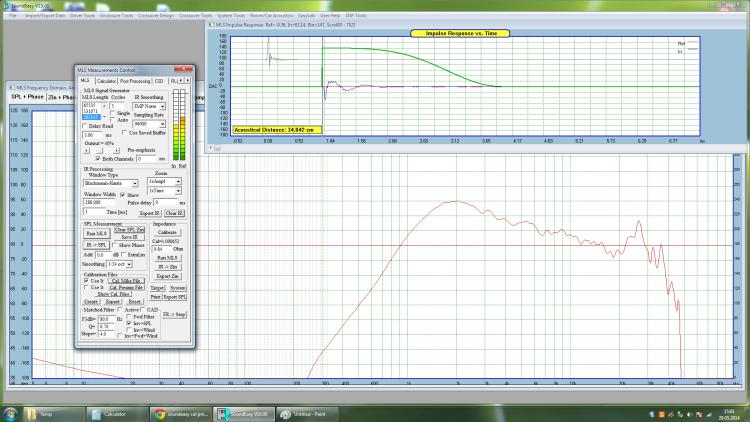
There are actually some measurements of the Tannoy raw drivers that confirm this precisely on this Norwegian forum – "measured a few degrees to the side", the tweeter frequency response looks quite amazing!
Phew!
But it feels good being confirmed by measurements. ;-)
Btw Tannoy themselves measure about 15deg off the central axis and recommend this for listening too.
IME with my Tannoy 3149 drivers (pepperpots) there is a clearly audible very narrow beam on axis which does not drop the 6dB/oct and hence becomes a bit strident once the correction is applied.
(Luckily biology works in a way that makes this less audible with increasing age.
I suspect this has something to do with the horns constant directivity ie this narrow central beam is unaffected by the horns cd profile and behaves somewhat like it would on a plane wave tube.
I also suspect that this problem arises when there is a direct straight path from the diaphragm to the outside as there exists with both tulip and pepperpot Tannoys.
IME with my Tannoy 3149 drivers (pepperpots) there is a clearly audible very narrow beam on axis which does not drop the 6dB/oct and hence becomes a bit strident once the correction is applied.
I'll try and validate that against 3rd measurements, again. ;-)
At least Tannoy's own detailed on- and off-axis FR measurements of the Definition Install series don't seem to show such a behaviour.
12" model:
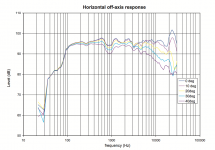
8" model:
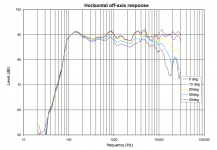
In what frequency range does your driver exhibit this behaviour? Do you have some measurements to illustrate it? That would be very helpful!
I suspect this has something to do with the horns constant directivity ie this narrow central beam is unaffected by the horns cd profile and behaves somewhat like it would on a plane wave tube.
I also suspect that this problem arises when there is a direct straight path from the diaphragm to the outside as there exists with both tulip and pepperpot Tannoys.
Shouldn't something like this also happen with other CD driver constructions, or don't they usually comprise such a straight path?
It's available from here: http://reconingspeakers.com/product/tannoy-dimension-td10-dual-concentric-driver/
Gesendet von meinem iPhone mit Tapatalk
Gesendet von meinem iPhone mit Tapatalk
In the frequency range where the cd-horn correction kicks in ie 5k+.I'll try and validate that against 3rd measurements, again. ;-)
At least Tannoy's own detailed on- and off-axis FR measurements of the Definition Install series don't seem to show such a behaviour.
12" model:
View attachment 440579
8" model:
View attachment 440580
In what frequency range does your driver exhibit this behaviour? Do you have some measurements to illustrate it? That would be very helpful!
Shouldn't something like this also happen with other CD driver constructions, or don't they usually comprise such a straight path?
It is only a very narrow beam right on axis, I'd guess the most offensive part is no more than 5deg.
The pepperpots like mine have a central hole in them and if you shine a light in it you can see the diaphragm.
(I just had a google and it seems the re-introduced pepperpots do not have this central hole anymore. Here is a picture of the original version: Tannoy Dual Concentric Speakers and one of the re-introduction, albeit a front view: http://www.positive-feedback.com/Issue49/images/5 Westminster driver.jpg )
Never bothered measuring it with mine as it was clearly audible when I was still running them passive and without a supertweeter and because in the tech manual that came with them Tannoy clearly stated that they measured them 15deg off axis as well as recommending listening to them that way.
May be Tannoy fixed that with the tulips.
I have seen a couple of up-market wedge monitors with added 'phase-plugs' mounted over the centre of their CD horns but that was some time ago.
As far as I can tell most compression drivers have proper phase plugs built into them thus there would be no straight path to the outside. Compression driver design made quite a large leap forward with computer aided design sometimes leading to a congruence of the solutions.
For example in a side view Tannoys tulips are remarkably similar in shape to the compression driver JBL came up with at roughly the same time for their K2 although there is quite a difference in size.
Bottomline: It seems I have been wrong in my assumption that tulips would exhibit the same problem as vintage pepperpots. Sorry about that and I for one hope I'll learn my lesson!
I see the wave guide as an "appliance" that tries to ensure that the waves coming from the moving element arrive in phase at the throat.
It does this by making the distance travelled by the wave the same from each point on the moving element to the throat.
Imagine the inverted dome as a surface with a 100mm radius, of a 200mm diameter sphere. Locate this curved surface 100mm away from the throat.
Between the dome and the throat insert the waveguide. The lengths of all the slots/holes are 99.5mm.
The dome is just 0.5mm away from the back surface of the guide.
Now make the distance from every point on the dome less than 4mm from the entry to the nearest slot/hole.
Some parts of the dome are only 0.5mm from a hole, while other parts can be upto 4mm away from a slot/hole. Every position on the dome is between 0.5mm and 4mm from a slot/hole.
Moving the dome makes the air in that 0.5mm gap move into a hole slot.
The air movement from all the dome surface elements is nearly "in phase" with each other.
The air travels down the equal length slots/holes and arrives at the throat within a phase error <3.5mm (the difference between 0.5mm and 4mm in that hypothetical example).
What effect @ 20kHz will that 3.5mm of maximum phase delay cause?
Whether it's a pepper pot with a central hole or a pepper pot without a central hole or a series of concentric slots, or some other guide, does not make any difference. What it is trying to do is minimise the DISTANCE DIFFERENCE from dome to throat.
The complicated versions are those that don't use an inverted dome and those that have a dome that is not a spherical surface at a constant distance from the throat.
The original pepper pot is probably the simplest in theory, it's the making of it in metal that has become expensive.
It does this by making the distance travelled by the wave the same from each point on the moving element to the throat.
Imagine the inverted dome as a surface with a 100mm radius, of a 200mm diameter sphere. Locate this curved surface 100mm away from the throat.
Between the dome and the throat insert the waveguide. The lengths of all the slots/holes are 99.5mm.
The dome is just 0.5mm away from the back surface of the guide.
Now make the distance from every point on the dome less than 4mm from the entry to the nearest slot/hole.
Some parts of the dome are only 0.5mm from a hole, while other parts can be upto 4mm away from a slot/hole. Every position on the dome is between 0.5mm and 4mm from a slot/hole.
Moving the dome makes the air in that 0.5mm gap move into a hole slot.
The air movement from all the dome surface elements is nearly "in phase" with each other.
The air travels down the equal length slots/holes and arrives at the throat within a phase error <3.5mm (the difference between 0.5mm and 4mm in that hypothetical example).
What effect @ 20kHz will that 3.5mm of maximum phase delay cause?
Whether it's a pepper pot with a central hole or a pepper pot without a central hole or a series of concentric slots, or some other guide, does not make any difference. What it is trying to do is minimise the DISTANCE DIFFERENCE from dome to throat.
The complicated versions are those that don't use an inverted dome and those that have a dome that is not a spherical surface at a constant distance from the throat.
The original pepper pot is probably the simplest in theory, it's the making of it in metal that has become expensive.
Last edited:
- Status
- This old topic is closed. If you want to reopen this topic, contact a moderator using the "Report Post" button.
- Home
- Loudspeakers
- Multi-Way
- Smoothest throat transition/frequency response in large pro coaxes?
